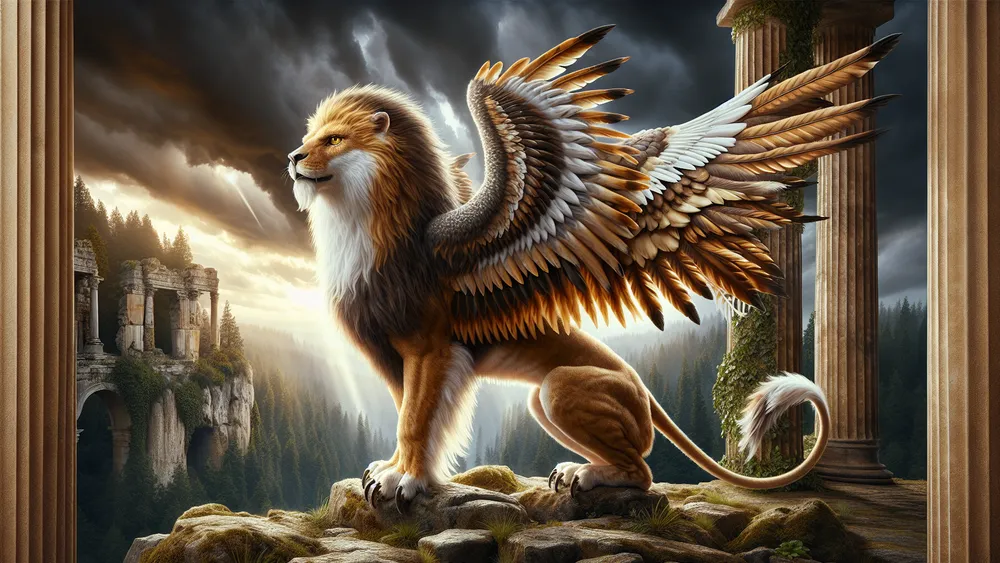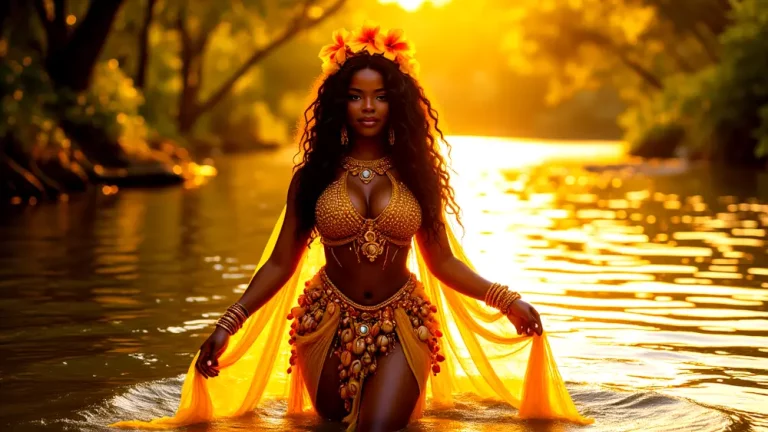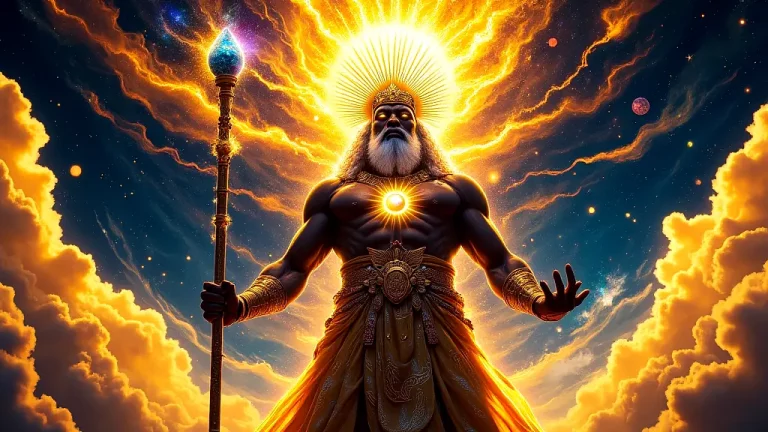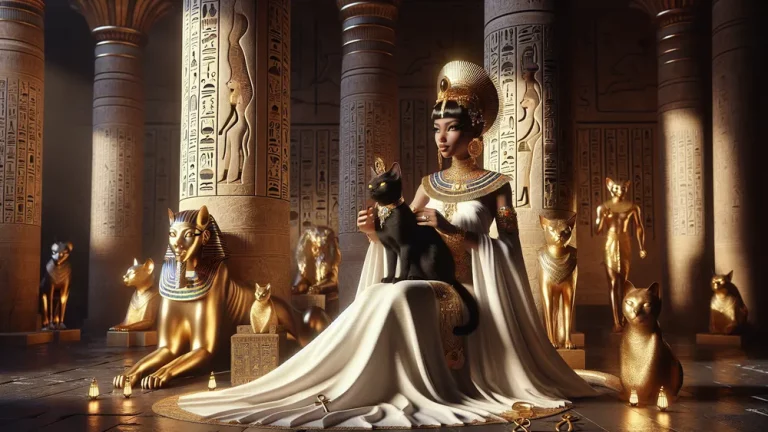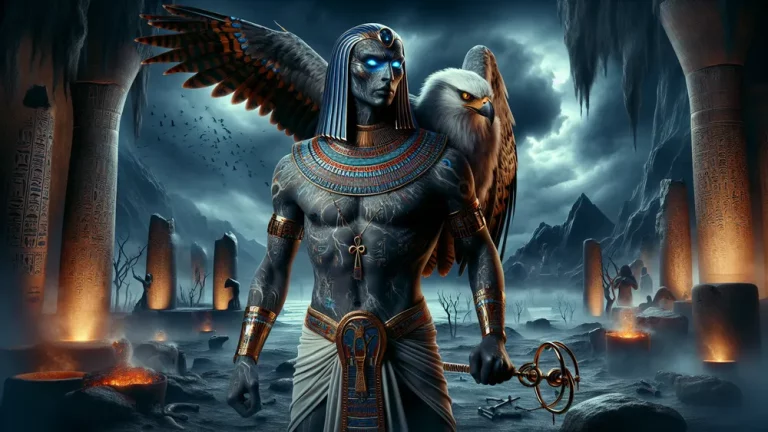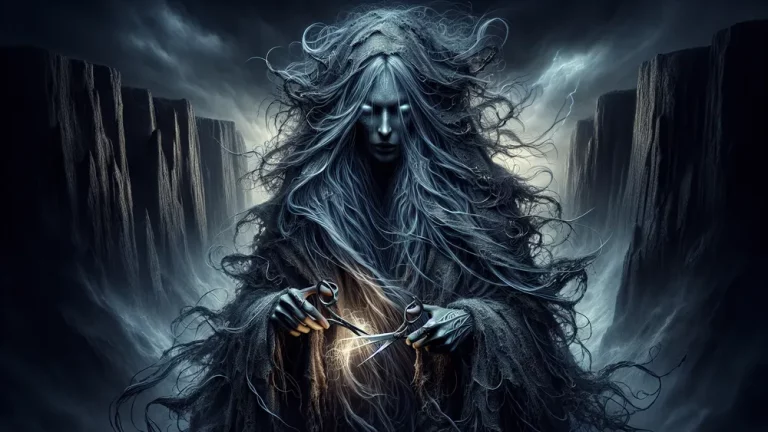Griffin: Mythical Creature With Lion Body and Eagle Head
Visualize an animal that mixes the grandness of a lion with the elegance of an eagle, a creature which has caught and intrigued many generations from different cultures. And that’s the griffin, a mythical beast having a lion’s body and wings plus head of an eagle.
Key Points:
- A griffin is a mythical creature with the body of a lion and the head and wings of an eagle.
- Griffins symbolize strength, bravery, and watchfulness in various cultures.
- They have been found in ancient Egypt, Mesopotamia, Greece, Rome, and medieval Europe.
- Griffins were protectors of treasures and holy places in myths and stories.
- The word griffin comes from Latin and Greek words meaning a hook-shaped nose like an eagle’s beak.
- Griffins are still popular in modern books, art, movies, and games.
- They are often seen as symbols of protection, power, and divine strength.
This blog post will look into the old stories about griffins, tracing where they came from, their importance in different cultures, and what they symbolize. Starting from ancient Egypt all the way to medieval Europe, the griffin has made a lasting impression on art, writings, and family crests.
Whether you love myths or are just new to the topic, this guide will give a thorough knowledge of the griffin’s place in history and its lasting effect on modern life.
griffin: Overview and Key Facts
| Aspect | Description | Examples/Notes |
|---|---|---|
| What It Is | A made-up animal with a lion’s body and an eagle’s head and wings. | Seen in old paintings and books. |
| What It’s Like | Mixes a lion’s power with an eagle’s sight and flying skills. | Stands for strength, bravery, safety. |
| Meaning | Means being on guard, holy power, and watchfulness. | Used in family symbols and old oaths. |
| Role in Stories | Acts like a shield for treasures and holy places. | Linked to gods like Zeus and Apollo. |
| Cultural Importance | Found in many places like Egypt, Mesopotamia, Greece, and Rome. | Each place has different meanings. |
| Today’s Impact | Still shows up in books, art, and movies now. | In things like “Harry Potter” and “Dungeons and Dragons.” |
Acts like a shield for treasures and holy places.
Getting to Know the Griffin
Now with a basic idea, diving deeper into the interesting details of the griffin’s special traits and long past. Its world, explored. This creature, not like any other, has stories to tell. Very old and full of wonder.
What Exactly is a Griffin?
A griffin, a mythical animal, has caught people’s imagination for a very long time. It is known for its mixture of parts from different animals, having the body of a lion together with the head and wings of an eagle.
Think of a lion’s strong body, also thought of for its power and greatness, mixed with an eagle’s head with sharp eyes, remembered for its sight and flying skill. This mixture of ground and sky ability makes the griffin stand for both power and alertness.
The lion’s body stands for bravery and strength, while the eagle’s head and wings stand for sharp sight and freedom.
In old stories, the griffin is shown as a guard of treasures and holy places, taking on the role of a protector. Its mixed nature lets it be a link between the ground and the sky, making it a strong symbol in many cultures. The meanings of the griffin are deep and different, often standing for:
- Guarding: Keeping valuable treasures and holy spots safe.
- Holy Power: Showing divine strength and control.
- Watchfulness: Showing alertness and sharp sight.
These meanings have made the griffin a key figure in art, books, and family crests, where it is often used to show messages of guarding, power, and spiritual understanding.
Origins of the Word and How to Say It
The word “griffin,” interestingly, has roots that shed light on its colorful history among different peoples. It comes from the Latin word “gryphus” and before that, from the Greek word “gryps,” which means a nose that’s curved or hooked, similar to an eagle’s beak. This word path shows the griffin’s key parts and its importance in old stories. To help you say “griffin” right in various languages, here is a table showing how to say it in English, Greek, and with phonetic sounds:
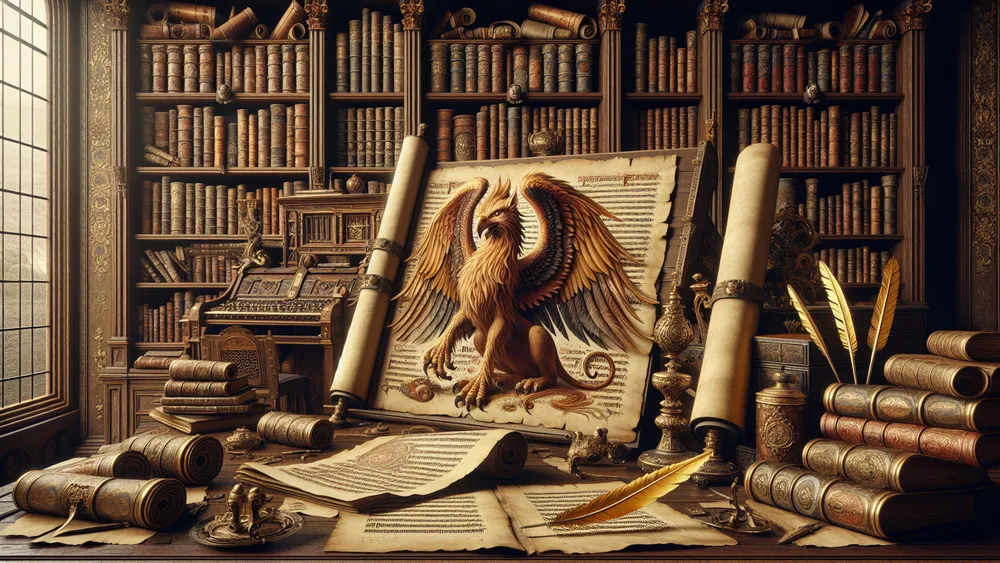
| Language | Word | Pronunciation (Phonetic) |
|---|---|---|
| English | Griffin | /ˈɡrɪfɪn/ |
| Greek | Γρύπας | /ˈɣrips/ |
History and Cultural Importance
Now knowing what a griffin is, its long history and meaning in old cultures, let’s find out. Different old times had stories about it. It mattered a lot.
Griffins in Ancient Egypt
In old Egyptian myths, the griffin was a respected animal shown many times in their art and stories. Different from the well-known sphinx, the griffin in Egypt was like a strong guard, often seen with a lion’s body and a falcon or eagle’s head. It showed a mix of power and sharp sight because these were important traits in Egyptian life.
It was said that the griffin kept safe holy places and treasures just like a lion protects its land and an eagle looks after its place from high up. The link with Horus, the god who had a falcon’s head, made the griffin even more important in these stories.
Horus, the sky and war god, meant kingship and safety. The griffin, having an eagle-like head, was thought of as a worldly sign of Horus’s godly nature. This link gave the griffin meanings of holy safety, kingly power, and watchfulness. Egyptians saw the griffin not just as a story creature but a strong sign of kings’ holy right and the gods’ protective strength.
Griffins in Mesopotamia and the Near East
In places like Mesopotamia and the Near East, the griffin was a major figure shown many times in their art and stories.
Differently from the Egyptian griffin that linked closely to certain gods, the Mesopotamian griffin was often shown as a mixed animal having the body of a lion and the head and wings of an eagle. This picture showed a mix of land and sky power, having the strength of a lion and the wide-seeing eyes of an eagle.
Many ancient groups like the Sumerians, Assyrians, and Babylonians often featured it in their art, including bas-reliefs, cylinder seals, and other items. The jobs and images of the griffin in these old cultures were varied. As in their myths, the griffin was seen as a keeper of holy places and protector, like in Egypt. They thought it kept away bad things and kept godly treasures safe.
Added to this, sometimes the griffin was linked with the sun god, showing both power and safety. Its image in the Near East also had royal meanings, showing the king’s godly right to rule and duty to keep his people safe. These varied meanings made the griffin an important and lasting figure in the stories and lives of Mesopotamia and the Near East.
Griffins in Greek and Roman Stories
In Greek and Roman myths, the griffin was a strong and grand beast. It had the body of a lion and the head and wings of an eagle. Often, it watched over godly places and riches. This mix of traits showed strength and alertness, making it a good protector of precious things.
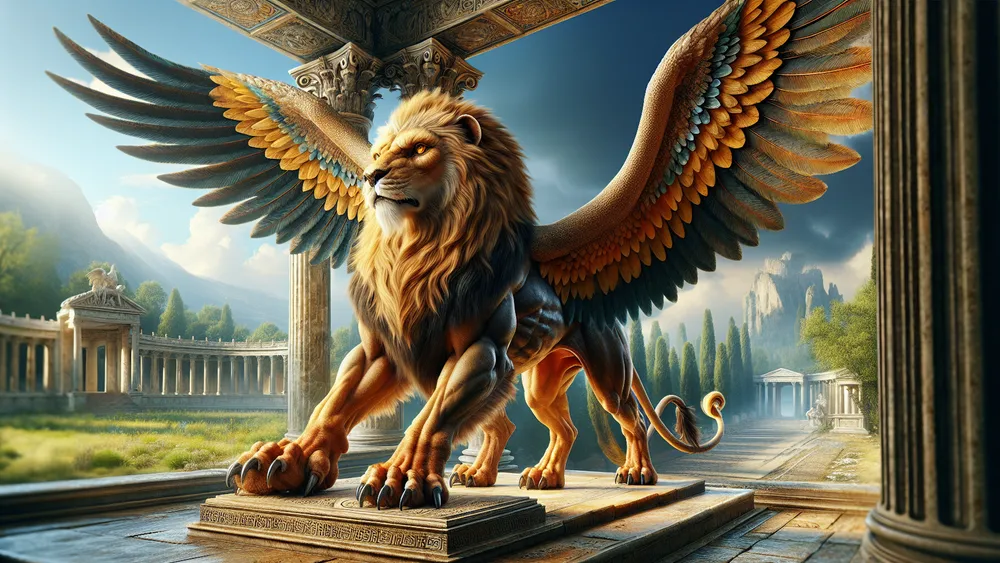
Greeks and Romans respected the griffin for its strong appearance and its job as a guard of godly treasures. Many stories pictured it as a fierce and loyal keeper. The link of griffins with gods like Zeus and Apollo made them even more important in Greek and Roman myths.
Zeus, the top god, often had ties with the eagle, showing his power and rule. So, the griffin, with its eagle-like head, was thought of as part of Zeus’s control over both the sky and ground. Also, Apollo, the god of the sun, music, and telling the future, was connected to the griffin.
Because of its sharp sight and grand look, it was seen as fitting for Apollo, showing his wide reach and protective nature. These ties gave the griffin godly traits, making it a respected creature in myth stories. Besides, the griffin was a big part of Greek buildings and writings. Statues and images of griffins often decorated temples and other holy places as protectors.
For instance, sculptures and carvings of griffins were often put at temple gates to keep away bad spirits and unwanted guests. In books, the griffin showed up in many old works like those by Herodotus and Aeschylus, where it was seen as a treasure guard and symbol of godly safety.
These art and story mentions made the griffin’s role as a strong and careful figure clear, firmly set in the Greek and Roman cultures.
Griffins in Medieval and Renaissance Europe
In old European tales, the griffin stood for power, bravery, and safety. Shown with a lion’s body and an eagle’s head and wings, people thought it had the best parts of these animals. Folk stories had griffins as keepers of riches and guards of holy things, like their old versions. In stories and legends, they were fierce and noble, showing the ideals of knights and bravery.
In family crests, the griffin was a common mark, standing for watchfulness, power, and leadership. The mix of the lion’s power and the eagle’s sharp eyes made it a fitting sign for noble families and knights wanting these traits. During the Renaissance, the meanings of the griffin changed to show the era’s new interest in old Greece and Rome, and humanism.
It still stood for safety and power, but also for wisdom and enlightenment. Artists and thinkers of the time looked at old Greek and Roman griffins for ideas, putting them in their work as signs of joining earthly and heavenly knowledge. In art, griffins were put in fancy cloth hangings, paintings, and sculptures, showing the blend of power and mind.
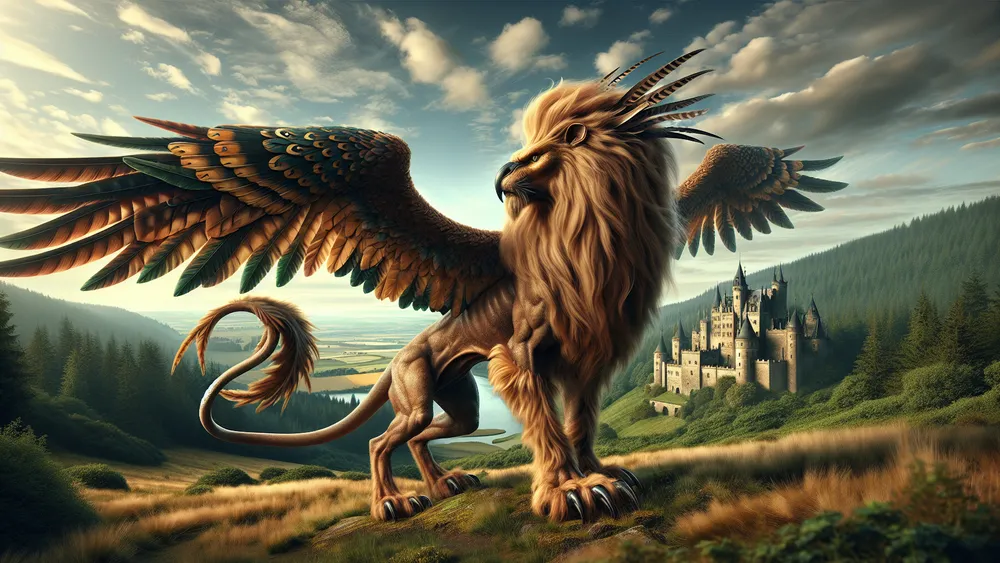
This time saw the griffin not just as a keeper of treasures but also of ideas and holy quests, showing the Renaissance values of balance and harmony.
Looks and Abilities
After talking about the long history and the cultural importance of the griffin, it’s time to look at how it looks and what it can do, which are very interesting.
What a Griffin Looks Like and What It Can Do
The griffin is a grand and impressive creature. People know it for having parts from both a lion and an eagle. Usually, it has a lion’s body, tail, and back legs. Also, it has an eagle’s head, wings, and sharp claws. This mix shows both land and sky skills. Griffins are big and strong, as large as a lion, but with the eagle’s big wings.
Their color can be different, but they are often shown with gold or brown fur and dark, sharp eagle feathers. Clear features like the eagle’s beak and strong eyes, along with the lion’s strong body and legs, make the griffin stand out in stories.
But more than their look, griffins have many special powers in myths. For instance, they can fly with their big, strong wings, going through the air with ease. Moreover, griffins are very strong, a trait from their lion half, which makes them strong fighters. Yet, griffins are also known as keepers of treasure and sacred places. Their believed powers include:
- Guarding Treasures: Griffins are thought to keep watch over large amounts of gold and precious stones, always watching over hidden wealth.
- Role as Protectors: Griffins are seen as guards of holy and special places, keeping temples, tombs, and other important spots safe from harm and evil.
These traits keep the griffin’s place as a sign of power, watchfulness, and safety in many myth stories.
Meaning and Symbols
After looking at the griffin’s looks and powers, we should talk about what it stands for and how it is shown.
Griffins in Heraldry and Religion
In family symbols, the griffin stands out and is respected. Coats of arms and family crests often have it. Its mixed form, with the power of a lion and the sharp sight of an eagle, makes it a perfect sign for showing alertness, bravery, and leadership.
Seen on a coat of arms, the griffin means the person showing it has these good traits and protects their land. Many knights and noble families in the past used the griffin as their symbol to show their courage and protection.
Because it looks fierce and grand, it was also chosen to show the strength and control of the family or group it represents. Moreover, in religion and spiritual ideas, the griffin has important roles. In Christianity, people often view the griffin as a sign of godly power and protection. It shows the two natures of Christ – both human and godly.

This idea comes from the griffin’s mix of earth and sky traits. In other beliefs, divine creatures are linked with the griffin, which is thought to watch over sacred places and treasures. Some myths say griffins guard holy places from evil powers. Their duty as keepers of both physical and spiritual treasures shows their key role in religious symbols, representing protection, watchfulness, and holy strength.
Impact on Modern Culture
After looking at the griffin’s deep meanings in family symbols and religion, you should also check out how it affects modern stories, pictures, and everyday stuff.
Griffins in Books, Art, and Pop Culture
In today’s stories and pictures, the griffin can be seen and captures people’s imagination. Inside books, they show up as grand and strong animals, representing power and guard duty. For instance, griffins in C.S. Lewis’s “The Chronicles of Narnia” books are shown as good and faithful partners in the fight against bad things.

Also, in J.K. Rowling’s “Harry Potter” books, a griffin shows up as Buckbeak, a hippogriff, which is sort of like a griffin’s cousin. Griffins also show up often in fantasy drawings and carvings, showing their grand shapes and keeping their status as famous mythical animals.
Furthermore, in everyday media like films, TV shows, and games, griffins have found their place. Their unique look and magical skills make them perfect fits for fantasy and adventure themes. Like in the game “Dungeons and Dragons,” griffins are strong creatures that players can meet and even ride.
In the “Harry Potter” movies, Buckbeak, who is like a griffin, appears with grand flying scenes and strong loyalty, making viewers love it. Additionally, games such as “World of Warcraft” and “Assassin’s Creed” feature griffins, showing them as either strong enemies or friends. Well-known griffin examples in popular media include:
- Dungeons and Dragons: Griffins are strong creatures players can meet.
- Harry Potter: Buckbeak the hippogriff, similar to a griffin, is important.
- World of Warcraft: Griffins are shown as grand rideable animals and beings.
- Assassin’s Creed: Griffins show up as mythical enemies in the game.
These instances show how the griffin keeps its attraction in today’s world, always making people feel awe and wonder.
Where Griffins Might Come From and Other Myth Creatures
Seeing the griffins’ influence on today’s culture, let’s look into their possible beginnings and see how they compare with other made-up creatures.
Theories on Griffin Origins and Other Similar Creatures
Where the idea of griffins came from is something that people talk a lot about. One guess is that the image came from old bones of Protoceratops, a dinosaur that lived in the Gobi Desert. Travelers and traders, from long ago, could have found these bones and thought they were from a creature with a lion’s body and an eagle’s head.
Another guess is that old cultures made it up by giving the best parts of a lion and an eagle to create a sign of great power and protection. How the griffin story got around different places could be because of long trade routes and cultural exchanges back then, letting the griffin be a shared sign of strength and guardianship.
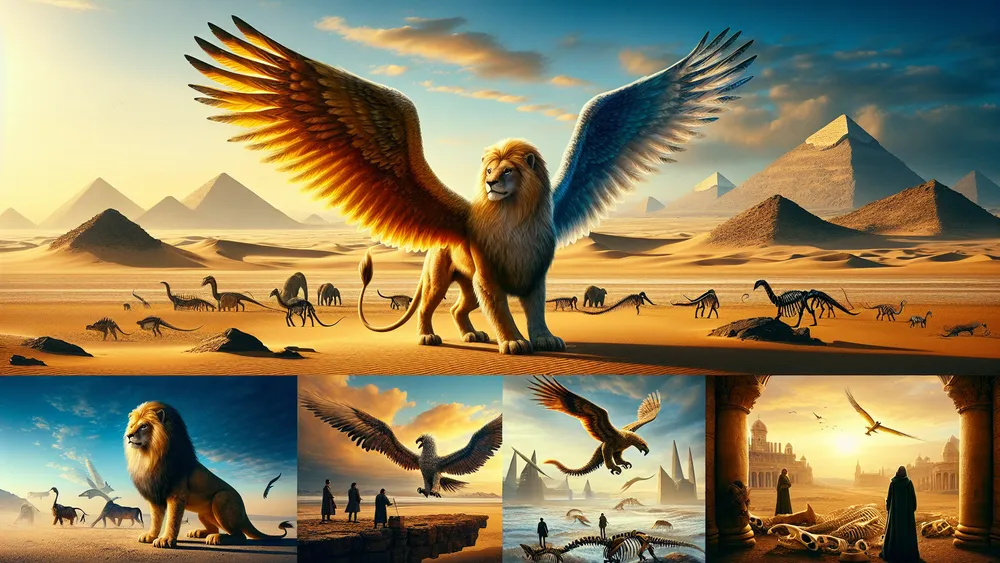
When you look at the griffin next to creatures like the sphinx and the hippogriff, you notice both similarities and differences. The sphinx, much like the griffin, is a mix of animals, often shown with a lion’s body and a human’s head. Both stand for power and safety, but the sphinx also stands for wisdom and mystery in Egyptian and Greek stories.
The hippogriff is different, with an eagle’s front half and a horse’s back half, mixing two kinds of animals. While the hippogriff shares the griffin’s flying ability and ties to nobility and bravery, it is often shown as a kinder and loyal friend in stories and art.
These comparisons show the different ways mixed creatures have been used to show complex symbolic meanings between different cultures and stories.
Pantheon of Mythical Creatures
The world of myth is full of many different made-up creatures, each one special with its own traits and stories. From the grand griffin to the puzzler sphinx, these beings have held human interest for a long time. Many places have their own amazing made-up animals, such as the dragons in Chinese stories, the unicorns in European old tales, and the phoenixes from ancient Egypt.
If you’d like to learn more about Egyptian tales, here is a link to a list of all creatures in Egyptian stories. These made-up creatures show what people in those cultures believed in and valued, and they still give ideas for today’s stories, art, and popular things.
FAQs
1. What is the origin of the griffin myth?
The origin of the griffin myth is believed to trace back to ancient civilizations such as Egypt and Mesopotamia, where it symbolized divine power and protection.
2. How is the griffin depicted in different cultures?
The griffin is depicted in different cultures as a powerful and majestic creature, often symbolizing strength, protection, and divine power.
3. What are the symbolic meanings of the griffin?
The symbolic meanings of the griffin include strength, courage, and protection, often representing a guardian of treasures and divine power.
4. How has the griffin influenced modern popular culture?
The griffin has influenced modern popular culture by appearing in various forms of media, including literature, movies, TV shows, and video games.

